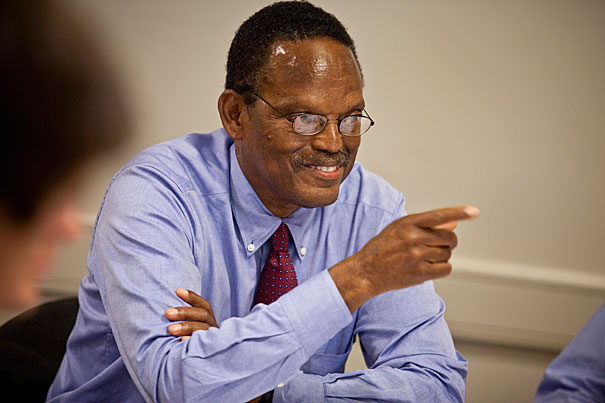
“‘The Wire’ does a really scrupulous exploration — gangs, police, unions, schools, government, etc.,” says William Julius Wilson, who leads “HBO’s The Wire and Its Contribution to Understanding Urban Inequality.” “Students become aware that individuals’ decisions and behavior are often influenced, shaped, and limited by political, social, and economic forces beyond their control.”
Justin Ide/Harvard Staff Photographer
Learning the streets, scene by scene
HBO’s ‘The Wire’ is entry point for course on urban life
D’Angelo Barksdale is a Baltimore drug dealer who wants out of the game. Tormented by the murders committed by his uncle Avon, leader of the Barksdale gang, he talks to the police. “I just wanna go somewhere — anywhere — where I can breathe like regular folks,” he says. “Gimme that, and I’ll give you Avon.”
Later, D’Angelo tells his mother that he wants to join the Witness Protection Program and start his life over. She ignores him at first, and then leans on him to protect his uncle. “How you gonna start over without your peoples?” she asks.
These scenes and others from the acclaimed television series “The Wire” are at the center of HBO’s The Wire and Its Contribution to Understanding Urban Inequality, a new course aimed at teaching Harvard undergraduates about inner-city life. Each week, students read academic research on topics that include crime, incarceration, work and labor markets, the economy, education, and politics, and submit response papers that link the scholarly work with themes featured in the show, which was created by David Simon.
William Julius Wilson, Lewis P. and Linda L. Geyser University Professor, leads the course. He says that he chose to build the class around “The Wire” because the show provides a comprehensive picture of the forces that shape urban life.
“‘The Wire’ does a really scrupulous exploration — gangs, police, unions, schools, government, etc.,” he says. “Students become aware that individuals’ decisions and behavior are often influenced, shaped, and limited by political, social, and economic forces beyond their control.”
Wilson’s 1996 book, “When Work Disappears: The World of the New Urban Poor,” was an inspiration for season two of the “The Wire,” which focused on the struggles of the working class in Baltimore. The show brings students to this research in a way that reading, discussion, and lecture can’t, he says.
“The show captures a reality that corroborates points I make in my work, such as the transformation of the inner city,” he says. “For instance, I try to explain in my writings why many inner-city neighborhoods have transformed from densely populated to depopulated areas. When my students watch ‘The Wire’ they can actually see what I am talking about.”
Chelsey Bowman ’12, a student in Wilson’s class, says that, as art, “The Wire” has the ability both to unite and depict the elements of the inner-city experience.
“The show combines all of the problems that social scientists research and write about,” she says. “I’ve taken a few other sociology classes that try to grapple with these topics, but without an aid like ‘The Wire’ the concepts can seem foreign or overstated to someone living in a college bubble.”
Bowman says that every point discussed in the reading assignments can be found somewhere in “The Wire.” She recently presented to Wilson’s class on Lawrence D. Bobo and Victor Thompson’s article “Racialized Mass Incarceration: Poverty, Prejudice, and Punishment,” and says that the show helped her understand the authors’ work on who goes to prison in the United States.
“In the last episode of season one of ‘The Wire,’ the police swarm low-rise projects and round up African-American men, regardless of whether or not they seem to be involved in the drug trade,” she says. “In another episode, though, we see drug dealers selling to white middle-class men and women, along with white college students. The scenes illustrate Bobo and Thompson’s claim that ‘illegal drug consumption seems to know no race. Incarceration for drug-related charges, however, is something visited in a heavily biased manner on African Americans.’”
Anmol Chaddha, an advanced graduate student in sociology who is co-teaching the course, acknowledges that one of the risks of using “The Wire” is that students will see it as fact, not fiction. He says that he and Wilson stress that the series is neither a documentary, nor a substitute for “rigorous scholarly research.”
“We tell students that the show is a way of leading into the academic work,” Chaddha says. “It’s a thread to integrate different topics that have an impact on urban inequality. It can give them a sense of what the issues are, but not a full understanding.”
Wilson never thought he would use a television show to help teach a course and resisted requests to do so from graduate students and from African and African American Studies Chair Evelyn Higginbotham. Now he says that the class has been one of the best experiences of his teaching career.
“I wake up in the morning so excited,” he says. “The students are so engaging and incredibly bright. I’m not only imparting knowledge, I’m learning something from their insights as they struggle to integrate the concepts we discuss in class.”
Kellie O’Toole ‘11 says that the most important thing she’s learning from Wilson’s class is that there is a connection between her life and that of someone who lives in the inner city.
“People in society attempt to distance themselves from the ‘other,’” she says. “‘The Wire’ works against this idea by depicting the connection between mainstream and street culture. It shows that, while people sometimes think they live in different worlds, we are more alike than we are different.”




